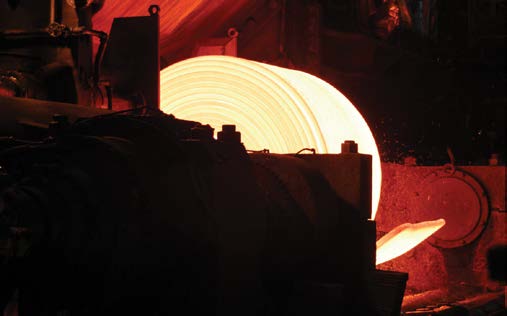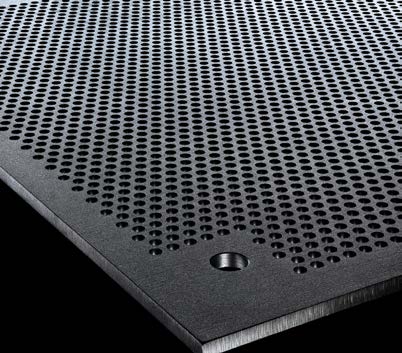Submitting Institution
University of CambridgeUnit of Assessment
Electrical and Electronic Engineering, Metallurgy and MaterialsSummary Impact Type
TechnologicalResearch Subject Area(s)
Engineering: Materials Engineering
Summary of the impact
This Case Study builds on our sustained effort since 1981 to understand
the nature of steel to an extent that enables the quantitative design of
novel alloys and processes. In 1997 this led to the development of Super
Bainite high-performance armour steel with an internal structure
distinguished by an unprecedentedly high population density of interfaces.
In 2011 this was licensed to Tata Steel who started manufacture at
their Port Talbot, South Wales plant. The steel is destined for armoured
vehicles. In a perforated design it has higher ballistic mass efficiency
and is less expensive than conventional armour. The work at Port Talbot
has re-established UK sovereign production of high-performance steel
armour, after a gap of over 20 years.
Underpinning research
Slender crystals of ferritic iron can be grown in the solid state from
austenitic iron, at a low temperature, by displacing the parent lattice
into that of the product. Excess carbon then partitions into the
austenite. The formation of this classical metallurgical structure, bainite,
has for many decades been difficult to interpret, because the atoms
involved have very limited mobility during the phase change. Harry
Bhadeshia (on the academic staff of the Dept of Materials Science
& Metallurgy (DMSM) at the University of Cambridge (UCAM)
1981 to date, and currently Tata Steel Professor) is noted
for example as the inventor of the ultra-tough steel used for the rails in
the Channel Tunnel. Supported by grants from a series of sponsors (Section
3), his systematic work has revealed the mechanisms and quantitatively
characterized bainite formation.
Bhadeshia pioneered the concept that there is no fundamental lower limit
to the temperature at which bainite can be produced, and predicted
refinement of its structure and improvement of properties by heat
treatment at lower temperature. Bhadeshia and FG Caballero (PDRA
in DMSM, July 1997 to July 1999) worked with the Ministry of Defence (MOD)
on designing a steel for gun-barrels, and discovered a bainitic steel that
had very desirable ballistic and mechanical properties (strength 2500 MPa;
toughness 40 MPa m1/2). A patent was filed on this new
composition and its manufacture [1], and a later paper [2] is highly
cited.
The new steel required heat treatment at 200°C for 10 days, making it
difficult to manufacture. Bhadeshia and C Garcia-Mateo (PDRA in
DMSM, July 2000 to June 2003), funded by the EPSRC and MOD, confirmed the
high strength obtainable at low temperature [3] and, crucially, showed how
the bainite transformation could be accelerated [4]. Aiming at designing a
steel for armour rather than gun-barrels, and using thermodynamic and
kinetic modelling, alloys were identified and selected variants were made
and tested. By the end, a Super Bainite steel with a
transformation temperature of 200°C (a lowish temperature more associated
with cooking pizza than with heat-treating steel!) that transformed in
hours and not days, had been identified. The resulting material,
with a strength in excess of 2500 MPa, has the highest density of
interfaces ever reported from a phase change alone; the low-temperature
treatment had created the world's first bulk nanostructured metal.
In this Super Bainite, the ferritic crystals are only 20-40 nm
thick.
From 2004, Bhadeshia worked with Dr Peter Brown from DSTL,
as a result of which Corus (now Tata Steel) was contracted
by DSTL to make tonnage quantities for large-scale evaluation
(Fig. 1). In 2008, [text removed for publication]
 Fig. 1. Super Bainite sheet under production†
Fig. 1. Super Bainite sheet under production†
Tata Steel's Swinden Technology Centre determined the
cooling-rate window, slow enough to avoid cracking but fast enough to
avoid the formation of deleterious carbide phases. In 2008 a patent [5]
was filed to protect the invention of a reduced-manganese nanostructured
alloy that transforms rapidly, based on the work by Bhadeshia and
Garcia-Mateo in collaboration with Brown, and further work has continued
with Tata Steel [6].
The development of Super Bainite has led to a burgeoning new
field of worldwide research [7]. At UCAM, further fundamental
discoveries have been made (e.g. the first ever prediction and observation
of non-cubic ferrite), and there are several new research projects on Super
Bainite ( its thermal stability, wear resistance, damage tolerance,
etc.).
References to the research
1. J Mawella, FG Cabellero & HKDH Bhadeshia: `Bainitic steel', World
patent WO0111096
2*. FG Caballero, HKDH Bhadeshia, KJA Mawella, DG Jones & P Brown:
Very strong low-temperature bainite, Materials Science and Technology
18 (2002) 279; DOI: 10.1179/026708301225000725 [148 citations as of
October 2013]
3*. C Garcia-Mateo, FG Caballero & HKDH Bhadeshia: Development of
hard bainite, ISIJ International 43 (2003) 1238; DOI:
10.2355/isijinternational.43.1238 [96 citations]
4*. C Garcia-Mateo, FG Caballero & HKDH Bhadeshia: Acceleration of
low-temperature bainite, ISIJ International 43 (2003)
1821; DOI: 10.2355/isijinternational.43.1821 [108 citations]
5. HKDH Bhadeshia, C Garcia-Mateo & P Brown: `Bainite steel and
methods of manufacture thereof', World patent WO/2010/013054, GB2462197,
US 2011/0126946 A1
6. Tata Steel Patent Pending: `Super Bainite steel and method for
manufacturing it' (to be assigned to MoD/Ploughshare Innovations),
application 10009375.6, 9th Sept. 2010.
7. HKDH Bhadeshia: The first bulk nanostructured metal, Science and
Technology of Advanced Materials 14 (2013) 014202; DOI:
10.1088/1468-6996/14/1/014202
*references best indicating the quality of the underpinning research.
Supporting research grants (all to Bhadeshia as PI):
(1) DERA, July 1997 to July 1999, £81,224
(2) EPSRC (GR/N14620/01), July 2001 to June 2003, `Very strong,
low-temperature bainite', £233,955
(3) QinetiQ, July 2003 to January 2004, £25,000
(4) DSTL, August 2012 to August 2015, £420,575.
Details of the impact
Despite the vast amount of empirical data available, the underpinning
fundamental research (Section 2) on atomic mechanisms was essential for
the design of steel compositions and heat treatments to achieve the
desired nanostructure without other undesirable reactions, as a function
of many variables. The key invention enabled the heat-treatment time at
the required low temperature to be brought within practical limits for
large-scale manufacture, as incorporated in the patent documents. We now
have the world's first bulk nanostructured metal, produced without
deformation, rapid heat-treatments or expensive solutes, and which can be
large in all three dimensions. The structure has the highest reported
density of interfaces in a bulk material, responsible demonstrably for the
properties achieved.
DSTL found that when perforated (Fig. 2), the steel has a ballistic
resistance exceeding that of well-established armour materials. Drilling
and hole-punching prior to heat-treatment results in an ultra-hard
perforated plate. The challenging technology by Tata Steel uses a
novel technique related to CNC punch tooling to achieve punching with
holes of diameter equal to or smaller than the gauge, while maintaining
the flatness of the plate. The new armour is fully protected by a patent
granted to the Secretary of State for Defence in which UCAM has a share in
royalties; supporting patent applications have been made worldwide. The
patents are licensed to Tata Steel (Europe) who have developed the
production technology to where [text removed for publication]. The
product, PAVISE™ Ultra High-Hardness Perforated Armour Steel,
is attracting approvals and initial orders from France, Germany, USA and
India, in addition to the MOD (press release of 03/09/2013, Section 5).
Production is based at Port Talbot. The steel as a perforated strike face
is one of the best metallic armours ever produced. [text removed for
publication]
 Fig. 2. Perforated Super Bainite armour†
Fig. 2. Perforated Super Bainite armour†
The initial focus is on UK armoured-vehicle programmes, extending to
Indian programmes, mainland Europe and the significant US market. The
perforated sheet is one of 7 forms intended for manufacture under Tata
Steel's licensing agreement with DSTL's technology-transfer partner
Ploughshare Innovations.†
The Minister for Defence Equipment, Support and Technology, Mr Peter
Luff, said [i]: "This cutting-edge UK invention and the manufacturing
agreement mean that the UK now has its own onshore supply of
high-performance armour steel. Super Bainite has both military and
civilian applications, providing Tata Steel with important export
opportunities. The application of new, battle-winning technologies is what
gives our troops the edge. This demonstrates, once again, that investing
in research and development, in partnership with industry, means that our
troops can have the latest innovations in front line equipment."
Production of the specialist armour-steel, and the successful development
of the downstream processing technology by UCAM scientists working with Tata
Steel, fulfils the UK MoD Defence Technology Strategy set out by
Lord Drayson in 2006. UCAM research has enabled the Ministry of Defence to
re-establish sovereign production of armour steel for the first time in
more than two decades. It is applicable in composite armour systems
enhanced with a perforated ultra-hard armour strike face, to resist potent
ballistic threats.
The new armour has stimulated interest in high-carbon steel production
within Tata Steel that had suffered serious technical problems in
the past, as steel production capability was lost in the UK. The
technology developed within Tata Steel for the continuous
manufacture of Super Bainite at an integrated factory, is directly
responsible for the reintroduction to the UK of the manufacture of
high-carbon steels. There is demand in Europe for up to 400k tonnes
per annum for items including springs, bearing cages and hand tools, where
hard and thin sheets are required. The reintroduction also supported Tata
Steel processes in Spain, [text removed for publication]
Towards expanding applications, new work has been funded by the MOD,
revisiting that done at UCAM [FG Caballero, HKDH Bhadeshia, KJA Mawella,
DG Jones & P Brown, Mater Sci Technol 17 (2001) 512].
Tata Steel now has teams looking at additional applications, e.g.
in highly-profitable wear-resistant plates for the mining industries.
Main types of impact
Economic — Performance of existing business improved
through new products & processes (Tata Steel production of
armour steel for worldwide market); A new business sector or activity
has been created (reintroduction of UK manufacture of high-carbon
steels); Performance improved through highly skilled people taking up
specialist roles that draw on their research (Many UCAM-trained
people now working at Tata Steel).
Public policy & services — Risks to the security of nation
states reduced (The MOD has access to high-performance
cost-effective armour, improving safety and performance of security
personnel; and UK sovereignty is protected by restoring indigenous
manufacture).
Society — Research has contributed to community regeneration
(inward investment into Tata Steel plant, safeguarding and
creation of jobs in Port Talbot, S Wales).
Sources to corroborate the impact
[i] Quotation from Peter Luff available at:
(https://www.gov.uk/government/news/new-armour-steel-showcased-at-dsei)
Tata Steel
The financial details and production quantities outlined above from Tata
Steel are commercially sensitive and should not be disseminated. They can,
however, be verified by the Sector Development Manager, Defence Products
Strategic Marketing.
Defence Science and Technology Laboratory (DSTL) (part of MOD)
A letter from the Deputy Chief Executive, DSTL verifying the claims made
about the armour, and how this enhances defence strategy first outlined in
2006.
The Senior Principal Scientist, Physical Sciences Group, at DSTL directly
involved in the UCAM collaboration can verify claims about the research
history leading to Super Bainite.
†Figures 1 and 2, and information on licensing (p. 3) are from:
DSTL Annual Report and Accounts 2011/12
http://www.official-documents.gov.uk/document/hc1213/hc01/0123/0123.pdf
Press releases and other coverage (list not exhaustive):
19th March 2008: DSTL press release "The story of the best
armour steel ever made"
http://www.msm.cam.ac.uk/phase-trans/2008/wired.pdf
28th August 2008: DSTL press release "Supporting UK Defence
Operations with innovative science and technology": https://www.dstl.gov.uk/downloads/28-08-08.pdf
3rd October 2008: Corus develops new low cost armour steel
http://www.tatasteeleurope.com/en/news/news/2008/2008_new_lowcost_armoured_steel
5th January 2009: BBC News "Holes give edge to new MoD armour"
http://news.bbc.co.uk/1/hi/sci/tech/7811567.stm
17th March 2010: DSTL press release: "Hole" new idea for
armour
https://www.dstl.gov.uk/downloads/17March2010-4.pdf
14th Sept 2011: DSTL press release "UK invention brings
sovereign capability for armoured steel"
https://www.dstl.gov.uk/downloads/20110914-Super_Bainite_Steel_PN_-_FINAL1.pdf
14th Sept 2011: Wales Online "Tata's Port Talbot
steelworks earmarked to produce super-steel to be used on front line"
www.walesonline.co.uk/news/wales-news/2011/09/14/tata-s-port-talbot-steelworks-earmarked-to-produce-super-steel-to-be-used-on-front-line-91466-29421333/#ixzz1j49GXDB4
3rd Sept 2013: Tata press release "Tata Steel's lightweight
armour steel can take a punch"
http://www.uk.tata.com/media/releases/inside.aspx?artid=Q0j5nZ6P4tc=